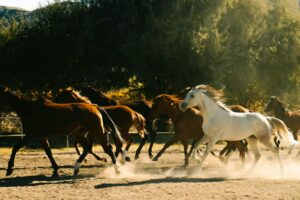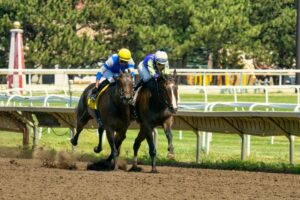Introduction to Horse Racing Tracks
Horse racing tracks hold a pivotal role in the equestrian sport, serving as the venues where thrilling competitions unfold. These tracks vary in design, purpose, and cultural significance, reflecting the rich history and diverse practices associated with horse racing across the globe. The importance of these sites extends beyond mere physical locations; they are central to the sporting culture, influencing the traditions, community events, and economic activities that surround this age-old pastime.
The history of horse racing tracks is as varied as the sport itself. They have transformed from informal dirt paths to sophisticated and well-maintained facilities designed to host thousands of spectators. Major tracks, such as Churchill Downs and the Ascot Racecourse, have become synonymous with prestigious events, showcasing not only elite thoroughbreds but also the fervor of the racing community. Racing tracks serve as cultural landmarks, embodying local heritage, and attracting regional, national, and international visitors. The fascinating blend of history and spectacle inherent to these tracks enhances their allure, establishing them as must-visit locations for racehorse enthusiasts.
Understanding the types of horse racing tracks is essential for appreciating the sport. Broadly, the main categories include thoroughbred tracks, harness racing tracks, and quarter horse tracks. Each type features distinct racing styles, rules, and horse breeds, contributing uniquely to the overall landscape of racing. Thoroughbred tracks typically showcase races that are longer in distance and demand a combination of speed and stamina, while harness tracks focus on a different racing format, where horses pull a sulky. Quarter horse tracks, on the other hand, emphasize quick, short-distance sprints, highlighting the incredible acceleration of these agile animals. Together, these various racing tracks not only enhance the sport’s appeal but also nourish a vibrant global culture steeped in equestrian tradition.
Churchill Downs: The Home of the Kentucky Derby
Churchill Downs, located in Louisville, Kentucky, is one of the most revered horse racing tracks in the United States, most notably recognized for hosting the Kentucky Derby. This prestigious event, often referred to as “The Run for the Roses,” has been held annually since 1875 and marks the beginning of the American Triple Crown of horse racing. This rich history reflects a storied tradition that captures the essence of thoroughbred racing in America.
The architecture of Churchill Downs is as iconic as the races it hosts, characterized by its stunning twin spires that rise above the grandstand. These spires are a symbol of the venue and have become a recognizable feature in sports culture. The racetrack itself features a one-and-a-quarter-mile dirt course and a smaller turf course, providing a venue that can accommodate both thoroughbred and turf racing. Each year, thousands of spectators descend upon Churchill Downs, both to revel in the excitement and to partake in the tradition of wagering—often a major part of the Derby experience.
On Derby day, the atmosphere at Churchill Downs transforms into a vibrant festival filled with anticipation and celebration. The event draws individuals from all walks of life, creating a unique blend of seasoned racing enthusiasts and first-time attendees. Attendees often dress in their finest attire, with elaborate hats being a distinctive tradition associated with the event. The significance of the Kentucky Derby extends beyond just horse racing; it reflects a deep-rooted cultural heritage associated with the sport.
Trends in attendance at Churchill Downs indicate a steady increase, showcasing the race’s growing popularity. Betting activity also tends to surge during this time, as several states allow online and mobile wagering. Churchill Downs stands as a testament to the enduring allure of horse racing, captivating new generations while honoring its rich past.
Royal Ascot: British Tradition Meets Glamour
Royal Ascot, held annually in June, stands as a pinnacle of horse racing and an epitome of British culture. Established in 1711, this prestigious event has evolved from a simple racecourse into a grand spectacle, attracting royals, celebrities, and racing enthusiasts from around the world. The Royal Family’s involvement adds an air of grandeur, as the event is traditionally opened by the Queen’s procession, a sight that resonates with historical significance and royal charm.
Throughout its illustrious history, Royal Ascot has maintained a focus on elegance and tradition. Attendees often don meticulously crafted outfits, with women wearing extravagant hats and men dressed in formal morning suits. This fashion aspect has become as integral to the event as the races themselves, marking Royal Ascot as a highlight on the social calendar and a showcase of sartorial creativity. The opportunity to witness such high fashion against the backdrop of thrilling horse races contributes to the event’s allure.
Among the esteemed races featured during Royal Ascot is the Gold Cup, which holds a prominent position in the horse racing calendar. The Gold Cup is not only a test of speed and endurance but also a proud demonstration of equine excellence. Other notable races include the Queen Anne Stakes and the King’s Stand Stakes, each offering its unique blend of competition and prestige. These races symbolize the event’s commitment to supporting the sport of horse racing while providing an unforgettable experience for spectators.
In essence, Royal Ascot represents the harmonious union of tradition, style, and high-stakes competition. It stands out as much more than just a horse racing event; it is a cultural phenomenon that celebrates British heritage in a way that is both captivating and enduring.
Flemington Racecourse: Home of the Melbourne Cup
Flemington Racecourse, nestled in Melbourne, Australia, stands as an iconic venue in the world of horse racing, primarily celebrated for hosting the famed Melbourne Cup. Each year, this prestigious event is often referred to as ‘the race that stops a nation,’ highlighting its profound cultural significance in Australia. The Melbourne Cup was first run in 1861 and has since evolved into a spectacle that attracts thousands of spectators, both on-site and across the nation via numerous broadcast platforms.
The racecourse itself boasts a rich history, having been established in the mid-19th century. Over the years, it has developed into a state-of-the-art facility equipped to accommodate large crowds, offering numerous hospitality options, luxury seating, and entertainment. This allows attendees to enjoy a thrilling atmosphere that perfectly complements the excitement of the races. The event on the first Tuesday of November epitomizes a celebration of Australian culture, bringing together people from various backgrounds who share a common passion for equestrian excellence.
Moreover, the Melbourne Cup is not merely a horse race; it symbolizes social gatherings, fashion, and a strong sense of community. The thoroughbreds that participate are often top contenders trained specifically for this notable event, making the competition fierce and exhilarating. Its global reputation has helped Flemington Racecourse attract an international audience, with many of the world’s best horses and jockeys vying for the coveted trophy. This not only enhances the prestige of the event but also emphasizes the racecourse’s position as a focal point in the equestrian calendar.
In conclusion, Flemington Racecourse holds a unique place in horse racing history, thanks to the Melbourne Cup. The combination of rich tradition, vibrant atmosphere, and immense importance in Australian culture makes it a must-visit for horse racing enthusiasts and newcomers alike.
The Dubai World Cup: A Global Racing Spectacle
Established in 1996, the Dubai World Cup has rapidly ascended to become one of the most prestigious and lucrative horse races in the global racing calendar. With a staggering purse exceeding $12 million, this annual event attracts some of the finest thoroughbreds from around the world, signifying its standing as a pinnacle of horse racing. Hosted at the state-of-the-art Meydan Racecourse, the World Cup showcases not only thrilling competition but also the opulence associated with the United Arab Emirates.
Meydan Racecourse, situated in the heart of Dubai, provides an impressive backdrop for this grand event. Opened in 2010, the venue boasts a capacity of over 60,000 spectators and features luxurious amenities such as premium hospitality suites, restaurants with panoramic views, and an extravagant grandstand. The racecourse itself is equipped with a top-notch dirt track and a turf course, ensuring favorable conditions for the competitors. It reflects Dubai’s commitment to becoming a global destination for horse racing and equestrian sports.
The level of competition at the Dubai World Cup is unparalleled. Every year, trainers and owners from various countries prepare their best horses to compete for the title. This international flair not only elevates the prestige of the event but also enhances the level of skill and talent on display. The influx of quality competitors has led to the growth of horse racing in the UAE, inspiring a new generation of racing enthusiasts and participants in the region.
Beyond the race itself, the Dubai World Cup serves as a focal point for a series of extravagant events, including parties, fashion showcases, and social gatherings that celebrate the glamour of horse racing. With its rich history, opulent setting, and international appeal, the Dubai World Cup has solidified its place as a global racing spectacle whose influence continues to expand each year.
Santa Anita Park: California’s Gem
Santa Anita Park, situated in Arcadia, California, is lauded as one of the premier horse racing venues in the United States. Established in 1934, this track not only boasts a striking backdrop of the San Gabriel Mountains but also embodies a rich tapestry of horse racing history that attracts both local enthusiasts and international visitors. The park has hosted countless pivotal races and events, making it an iconic landmark in the world of equestrian sport.
One of the highlights of Santa Anita Park is the Santa Anita Derby, a prestigious race that showcases some of the best thoroughbreds in North America. This event, held annually in early April, serves as a key stepping stone for horses aspiring to compete in the renowned Kentucky Derby. The Derby carries significant weight in the racing community, with its history tracing back to 1935. It is a hallmark of the park’s commitment to high-quality racing and attracts a large audience, further cementing its reputation within the sport.
Over the years, Santa Anita Park has evolved, adapting to the changing landscape of horse racing. It has faced its share of challenges, including economic fluctuations and significant welfare concerns surrounding equine athletes. In recent years, the racetrack has implemented enhanced safety measures and improved horse care protocols to ensure a safe environment for both horses and riders. These efforts reflect a growing commitment to maintaining Santa Anita’s standing as a leader in the industry.
Today, Santa Anita Park continues to serve as a crucial hub for horse racing in North America. Its commitment to excellence and innovation not only preserves its storied legacy but also ensures that it remains a vibrant part of the equestrian world for decades to come.
Longchamp Racecourse: The Heart of French Racing
Longchamp Racecourse, situated in the Bois de Boulogne in Paris, stands as a symbol of excellence in the realm of thoroughbred racing. It is widely recognized as the premier venue for horse racing in France, earning its esteemed reputation through a rich history and a series of prestigious events. Established in 1857, Longchamp has played host to some of the most significant horse races in the world, including the iconic Prix de l’Arc de Triomphe. This flagship event, inaugurated in 1920, represents the pinnacle of European racing and attracts top contenders from around the globe, solidifying Longchamp’s status as a must-visit destination for racing enthusiasts.
The allure of Longchamp extends beyond its major races. The racecourse encompasses a beautiful setting that harmonizes nature and sport, characterized by expansive green spaces and charming views. The unique atmosphere created at Longchamp is enhanced by its historical architecture and well-maintained facilities, providing an exceptional experience for spectators. As a result, horse racing aficionados flock to this venue, not only to witness breathtaking races but also to immerse themselves in the cultural richness that Longchamp embodies.
Moreover, the cultural significance of horse racing in France cannot be underestimated. It is a celebrated sport that encompasses tradition, competition, and social gathering. Longchamp serves as a hub for this culture, where both seasoned bettors and casual visitors can enjoy the thrill of the races while personally engaging in local gastronomic offerings and experiencing the vibrant social scene. The connection between the racecourse and its Parisian surroundings further emphasizes the importance of Longchamp within the broader context of French heritage. Thus, Longchamp Racecourse remains a cornerstone of French racing, captivating its visitors with the elegance and excitement that this sport has to offer.
Ascot Racecourse: A Blend of Tradition and Innovation
Ascot Racecourse, located in Berkshire, England, is one of the most prestigious horse racing venues in the world, renowned for its deep-rooted history and innovative approach to the sport. Established in 1711 by Queen Anne, the racecourse has evolved into a symbol of equine excellence and elegance, hosting a variety of significant racing events throughout the year. Although the highlight is undoubtedly the Royal Ascot, other major races, such as the King George VI and Queen Elizabeth Stakes and the Ascot Summer Mile, showcase the versatility and thrill that Ascot offers.
Beyond its racing schedule, Ascot Racecourse is committed to fostering connections within the community. The venue frequently engages in initiatives designed to promote the sport of horse racing to a broader audience, such as outreach programs and educational workshops. These efforts not only aim to cultivate future generations of racing enthusiasts but also to enhance local tourism and economy through various events hosted at the venue. Ascot’s approach in this regard demonstrates an understanding of the importance of community involvement in sustaining the future of horse racing.
Recent upgrades at Ascot Racecourse reflect a dedication to enhancing the spectator experience. With advancements such as improved seating arrangements, state-of-the-art hospitality facilities, and elevated safety measures, the track ensures that visitors enjoy not only the thrill of the races but also impeccable comfort. The blend of traditional values with modern amenities situates Ascot as a forward-thinking venue that respects its heritage while adapting to contemporary expectations. This balance has reinforced Ascot’s reputation internationally, drawing in attendees from around the globe eager to experience both the refinement of British horse racing and the excitement that characterizes the racecourse today.
Conclusion: The Global Importance of Horse Racing Tracks
Throughout this exploration of the world’s finest horse racing tracks, we have uncovered the rich history and cultural significance that these venues represent. From the storied traditions maintained at iconic tracks like Churchill Downs in the United States to the prestigious ambiance of the Ascot Racecourse in the United Kingdom, each racetrack embodies a unique blend of local culture, sporting excellence, and global community. The world of horse racing transcends geographical boundaries, uniting diverse populations through a shared passion for the sport.
Horse racing is not merely a competition; it is an event that fosters social interaction, economic development, and tourism in both urban and rural settings. Events hosted at these tracks can attract thousands of spectators, offering numerous opportunities for local businesses and communities to thrive. Moreover, these horse racing tracks serve as platforms where traditions are celebrated, and new cultural trends can evolve, showcasing the adaptability of this ancient sport in a modern context.
Looking ahead, the future of horse racing tracks appears promising as they continue to evolve. While they preserve their rich heritage, there is also a concerted effort to modernize facilities and enhance the spectator experience. Innovations in technology, better amenities, and comprehensive training programs for horsemen and women are crucial for attracting a new generation of fans. By doing so, these tracks play a vital role in ensuring the sustainability of horse racing as a beloved sport. The integration of local communities with global horse racing events strengthens the sport’s relevance, ensuring that it remains an integral part of cultural celebrations worldwide.




